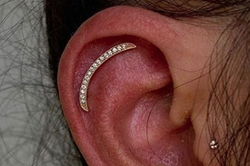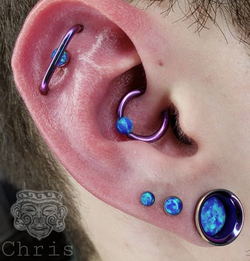Piercing Aftercare

About the Materials We Use: We use ASTM certified jewelry materials for initial piercing (astm.org). This means they are proven safe for use in piercing applications by scientific testing. Any jewelry that is made of materials that are not certified for human implant applications should be treated as novelty jewelry and never worn in contact with body fluids or worn for extended periods of time. Serious and permanent damage to skin and vital organs can occur from certain materials as toxins from the materials are absorbed through your skin and into the bloodstream.
PROPER FIT GUARANTEED: We guarantee the fit of your piece. Jewelry for new piercings should be fitted for comfort without excessive movement. Contact us for replacement if you think it might be loose or tight. Tight jewelry tends to indent the opening. Loose jewelry tends to move about and cause irritation.
HOW THE BODY HEALS: The body will heal by sealing the new opening and defending itself with white blood cells and your natural healing factors. New skin can grow very quickly when a piercing gets protection from irritation and infection. The body heals quickest when protected and left alone, usually in 30-90 days. The better your nutrition and care during this time, the quicker your piercing will heal.
WHAT YOU NEED TO DO: Protect your piercing from biological and chemical contamination. Don't use any antibacterial or antibiotic products, peroxide, or alcohol on your piercing. Twisting and turning your jewelry have not proven useful in healing piercings and are not required. It is irritating like picking a scab. Check the jewelry regularly and keep the ends tight at their connections. Wash your hands thoroughly and then use medical gloves, sterile gauze, paper towel or folded tissue to grip without direct contact. If you are wearing an occlusive bandage such as TEGADERM for your nipple or navel piercing ensure that the seal is watertight and replace the dressing when the edges start to peel up.
YOUR HEALING: Your piercing should look good and feel healthy every day. You should never feel extremes of pain, swelling, redness, heat, discolored discharge, or weeping from any piercing. These are signs of a problem
What to Expect

Phase 1: This occurs in the first few weeks
Dry, small scab forms around the jewelry; skin begins to grow. Keep the piercing isolated, dry, and clean. Don't touch, move or rotate the jewelry. Avoid pressure from tight clothing, or sleeping on your piercing, etc., which can cut off the circulation and slow healing. Don't contaminate your piercing with dirty hands, soap, tap water, make up, or skin care products, etc. While bathing or swimming, keep the piercing dry. Keep your back to the shower and cover it up with a plastic cup, or wear a waterproof seal such as TEGADERM (latex free). Prior to applying any bandage over the piercing, clean off the area surrounding the piercing using a gauze pad and distilled water (take care to avoid the jewelry and the wound).
AVOID GETTING THE PIERCING WET OR DIRTY FOR FASTER, EASIER HEALING. AVOID SEXUAL AND ORAL CONTACT WITH UNHEALED PIERCINGS.
Use barriers such as condoms, gloves, and dental dams even with a monogamous partner. Healthy nutrition and avoiding alcohol, smoking, and drugs will benefit your piercings. GET YOUR VITAMINS AND MINERALS!
If it gets wet, rinse with distilled water and blot dry with sterile gauze or tissue. Make sure it gets completely dry again. If it gets dirty wash it with a mild liquid soap (such as castile, olive oil or glycerin without dye, fragrance, moisturizer, deodorant, or antibacterial ingredients), then rinse and blot dry as described above
Phase 2: Usually occurs after the first week
Healthy people will notice the inside sheds dried scab and cellular waste material; the growing of new skin is delicate. Continue to protect it until skin is sturdy and has completely healed and no more of the waste material is secreted on the jewelry. Jewelry should not be moved or changed at home until solid healthy skin has sealed the area. We can do it for your safety.
Phase 3: Usually occurs within 30-90 days
For a healthy individual, by now a tunnel of skin should be sturdy and sealed. Keep cleansers, shampoo, and soaps out of the opening and off the jewelry. Rinse well if you do get anything on or in the piercings. Blot dry with sterile gauze or tissue after bathing to prevent irritation from moisture retained inside. Rinse and dry after bathing when healed. When the skin has become sturdy, you can carefully ease back in to you regular activities. Changing jewelry on your own should be easy when the piercing is healed. We have many options waiting for you: shapes, colors and gems! Should you take out your jewelry for an extended period of time, reinsertion could become difficult. The longer the jewelry is left out, the tighter and more difficult reinsertion can be. The elastic nature of skin can make a healed piercing shrink, but not sealed shut. We can usually put the jewelry back in for you pretty easily with a guide taper, as soon as possible after you remove it.
Oral Care

Use a new mechanical toothbrush and bottled water to brush teeth and tongue each day after eating or drinking during healing. Keep it cold. Wash out food particles and residues with bottled water after meals and snacks. This will help avoid bad breath and infection. Don't use toothpaste, mouthwash, peroxides or other oral care products during healing. Such products do not aid in the healing and may irritate the piercing. Use bottled water and mechanical toothbrush instead. Drink plenty of cold liquids (ice water, fruit juice, and electrolyte drinks). Continue until the area has relaxed back to normal. Ice should be soothing if applied consistently for the first few days until any swelling is completely gone.
AVOID ORAL CONTACT WITH ANYTHING IRRITATING, KISSING OR ORAL SEX WITHOUT PROTECTIVE BARRIER, SMOKING, ALCOHOL, SPICY, SALTY, SUGARY, OR HIGHLY ACIDIC FOOD AND DRINK, ETC. UNTIL HEALED.
Within two weeks come back and change to a shorter post to prevent potential damage to teeth and gums. A closer fit will reduce wear and increase comfort. You keep your longer post, as it may be useful later. Skin colored (matte pink) titanium pieces are suggested for disguise and can also be used for healing. However, there are currently no clear or flesh tone plastic pieces that meet ASTM standards for implant certification.
IN CLOSING
Please come back and show us your results as part of our ongoing process of improvement and development of our techniques and documentation of our work. You play an important role in our quest to make the art and service of piercing safe, simple, and gentle.
At 30 days, please visit for free follow up info.
